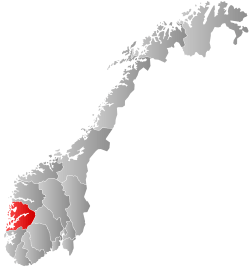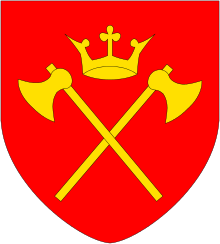Sund, Norway
| Sund kommune | |||
|---|---|---|---|
| Municipality | |||
Muret.jpg) View of an old stone fence on the island of Sotra | |||
| |||
 Sund within Hordaland | |||
| Coordinates: 60°13′56″N 05°06′17″E / 60.23222°N 5.10472°ECoordinates: 60°13′56″N 05°06′17″E / 60.23222°N 5.10472°E | |||
| Country | Norway | ||
| County | Hordaland | ||
| District | Midhordland | ||
| Administrative centre | Skogsvåg | ||
| Government | |||
| • Mayor (2013) | Kari-Anne Landro (H) | ||
| Area | |||
| • Total | 99.54 km2 (38.43 sq mi) | ||
| • Land | 94.68 km2 (36.56 sq mi) | ||
| • Water | 4.86 km2 (1.88 sq mi) | ||
| Area rank | #381 in Norway | ||
| Population (2017) | |||
| • Total | 7,058 | ||
| • Rank | #149 in Norway | ||
| • Density | 74.5/km2 (193/sq mi) | ||
| • Change (10 years) | 24.5% | ||
| Demonym(s) | Sundsokning[1] | ||
| Time zone | UTC+01:00 (CET) | ||
| • Summer (DST) | UTC+02:00 (CEST) | ||
| ISO 3166 code | NO-1245 | ||
| Official language form | Nynorsk | ||
| Website |
www | ||
Sund is a municipality in Hordaland county, Norway. The municipality is located in the traditional district of Midhordland. The administrative centre of the municipality is the village of Skogsvåg. Other larger villages in Sund include Klokkarvik, Tælavåg, Kausland, and Hammarsland.
Sund covers the southern third of the island of Store Sotra, west of the city of Bergen. It also includes many smaller, surrounding islands. The history of the municipality dates back to 1838, when Sund was first established as a formannskapsdistrikt, the precursor of the modern municipalities. Sund is a predominantly rural municipality, with no major settlements, the largest being Hammarsland with approximately 900 inhabitants (in 2013). Due to the proximity to the city of Bergen, a large proportion of the population commutes to the city to work.
The 100-square-kilometre (39 sq mi) municipality is the 381st largest by area out of the 422 municipalities in Norway. Sund is the 149th most populous municipality in Norway with a population of 7,058. The municipality's population density is 74.5 inhabitants per square kilometre (193/sq mi) and its population has increased by 24.5% over the last decade.[2]
General information

The parish of Sund was established as a formannskapsdistrikt (municipality) on 1 January 1838. It originally included many islands to the southwest of the Bergen Peninsula. On 1 January 1886, the southern archipelago in Sund (population: 2,396) was separated to form the new municipality of Austevoll. This left Sund with 2,112 residents.[3]
On 1 January 2020, the three neighboring municipalities of Fjell, Sund, and Øygarden will be merging into one large island municipality called Øygarden.[4]
Name
The municipality was named after the old Sund farm, where the first Sund Church was built. The name is identical with the Norwegian word "sund", which translates into English as "strait".[5]
Coat-of-arms
The present municipal coat-of-arms was granted on 23 March 1988. They show a blue lighthouse on a white or silver background.[6][7]
Churches
The Church of Norway has one parish (sokn) within the municipality of Sund. It is part of the Vesthordland deanery in the Diocese of Bjørgvin.
| Parish (Sokn) | Church Name | Location of the Church | Year Built |
|---|---|---|---|
| Sund | Sund Church | Klokkarvik | 1997 |
| Kausland Church | Kausland | 1881 |
Transport
The Sotra Bridge, opened in 1971, drastically improved travel to and from Sund and it spurred rapid population growth after ages of stagnancy. Due to the rapidly increasing traffic across the bridge and on the highways of Sotra, the Norwegian Public Roads Administration developed plans in the 2000s for a new bridge and highway between Bergen and Sotra. The plans include a new dual carriageway bridge to replace the Sotra Bridge, and new highways that lead northwards to Øygarden and southwards to Sund.[8]
History
| Historical population | ||
|---|---|---|
| Year | Pop. | ±% |
| 1951 | 2,998 | — |
| 1960 | 3,092 | +3.1% |
| 1970 | 3,110 | +0.6% |
| 1980 | 3,900 | +25.4% |
| 1990 | 4,976 | +27.6% |
| 2000 | 5,160 | +3.7% |
| 2010 | 5,995 | +16.2% |
| 2017 | 7,058 | +17.7% |
| Source: Statistics Norway. | ||
| Population development, 1951-2008 | ||
|---|---|---|
 | ||
| Source: Statistics Norway | ||
On 26 April 1942, after having discovered that two men from the Linge company were being hidden in Telavåg, the Gestapo arrived to arrest the Norwegian officers. Shots were exchanged, and two prominent German Gestapo officers, Johannes Behrens and Henry Bertram, and the Norwegian Arne Værum, were shot dead. Reichskommissar Josef Terboven ordered the Gestapo to retaliate, burning all buildings in the village, executing or sending the men to the Sachsenhausen concentration camp, and imprisoning the women and children for two years. In addition, 18 Norwegian prisoners at a Norwegian internment camp were killed as a reprisal.[9] The event has since become known as the "Telavåg tragedy", and is sometimes compared to similar World War II atrocities, such as the Lidice massacre, with higher death tolls.[10]
Geography
Sund covers the southern third of the island of Store Sotra, as well as the many islands that surround it. The largest of the smaller islands are Toftøya, Lerøyna, Bjelkarøyna, Tyssøyna, Risøy, Vardøy, Golten, and Viksøy. In total, the municipality encompasses 466 islands and skerries, which gives it a total coastline of about 110 kilometres (68 mi).[11]
The highest peak in Sund is the 284-metre (932 ft) tall Førdesveten.[11]
The fjord separating Store Sotra from the mainland, Korsfjorden, is historically the most used sea route into the city of Bergen, and is as much as 600 metres (2,000 ft) deep in some places. The treacherous waters in the area mean there has been a continuous need for piloting services, and this tradition is kept alive by the "Viksøy Losstasjon".
Climate
On an average, Sotra experiences 1,328 millimetres (52.3 in) of rainfall annually, less than the 2,250 millimetres (89 in) that the nearby city of Bergen receives. The year-round average temperature is 7.6 °C (45.7 °F), with the coldest month being February, when the average temperature reaches 2.1 °C (35.8 °F). The warmest month is August, with an average temperature of 12.8 °C (55.0 °F).[11]
Settlements
There are six urban settlements, as defined by Statistics Norway, within the border of the municipality. The largest is Hammarsland in northern Sund, with 875 inhabitants as of 2013. The others are Tælavåg, Skogsvåg, Klokkarvik, Forland, and Glesnes.[12]
Government

All municipalities in Norway, including Sund, are responsible for primary education (through 10th grade), outpatient health services, senior citizen services, unemployment and other social services, zoning, economic development, and municipal roads. The municipality is governed by a municipal council of elected representatives, which in turn elect a mayor.
Municipal council
The municipal council (Kommunestyre) of Sund is made up of 21 representatives that are elected to four year terms. Currently, the party breakdown is as follows:[13]
| Party Name | Name in Norwegian | Number of representatives | |
|---|---|---|---|
| Labour Party | Arbeiderpartiet | 6 | |
| Progress Party | Framstegspartiet | 3 | |
| Conservative Party | Høgre | 7 | |
| Christian Democratic Party | Kristelig Folkeparti | 1 | |
| Centre Party | Senterpartiet | 2 | |
| Socialist Left Party | Sosialistisk Venstreparti | 1 | |
| Liberal Party | Venstre | 1 | |
| Total number of members: | 21 | ||
References
- ↑ "Navn på steder og personer: Innbyggjarnamn" (in Norwegian). Språkrådet. Retrieved 2015-12-01.
- ↑ Statistisk sentralbyrå (2017). "Table: 06913: Population 1 January and population changes during the calendar year (M)" (in Norwegian). Retrieved 2017-10-28.
- ↑ Jukvam, Dag (1999). "Historisk oversikt over endringer i kommune- og fylkesinndelingen" (PDF) (in Norwegian). Statistisk sentralbyrå.
- ↑ "Vår nye kommune" (in Norwegian). Retrieved 2017-10-28.
- ↑ Rygh, Oluf (1910). Norske gaardnavne: Søndre Bergenhus amt (in Norwegian) (11 ed.). Kristiania, Norge: W. C. Fabritius & sønners bogtrikkeri. p. 257.
- ↑ "Civic heraldry of Norway - Norske Kommunevåpen". Heraldry of the World. Retrieved 2014-12-17.
- ↑ "Kommunevåpen for Sund kommune" (in Norwegian). Sund kommune. Retrieved 2014-12-17.
- ↑ "Fastlandssambandet Sotra-Bergen" (in Norwegian). Statens Vegvesen. 2014. Retrieved 2012-12-17.
- ↑ Berit Nøkleby. "Telavåg". NorgesLexi (in Norwegian). Archived from the original on 2013-05-29. Retrieved 2008-09-26.
- ↑ Eirik Gurandsrud (2005). "Telavåg i tid og rom : Erindringen om et krigsherjet fiskerisamfunn" (PDF) (in Norwegian). University of Bergen. Archived from the original (PDF) on 2007-02-21. Retrieved 2008-09-26.
- 1 2 3 Irene K. Melkevik. "Fakta om Sund" (in Norwegian). Sund kommune. Retrieved 2008-09-26.
- ↑ "Urban settlements. Population and area, by municipality". Statistics Norway. 1 January 2013. Retrieved 2014-12-17.
- ↑ "Table: 04813: Members of the local councils, by party/electoral list at the Municipal Council election (M)" (in Norwegian). Statistics Norway. 2015.
External links
| Wikimedia Commons has media related to Sund, Hordaland. |
- Municipal fact sheet from Statistics Norway (in Norwegian)


